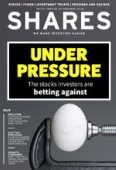Archived article
Please note that tax, investment, pension and ISA rules can change and the information and any views contained in this article may now be inaccurate.
When might inflation peak and what is behind the surge?

Having initially underestimated how ‘sticky’ it would be, and faced with the added impetus of soaring energy prices due to the invasion of Ukraine, central banks around the world are being forced to hike rates to stop inflation rising, even at the risk of choking off growth.
The latest inflation figure from the US was worse than expected, proving again that interest rates are a blunt tool when it comes to trying to bring prices under control.
A SERIES OF UNFORTUNATE EVENTS
It is ironic to think that a few years ago the prospect of rates being lower for longer was most peoples’ main concern.
Even though rates had been low for an unusually long time, there was little sign of inflation until Covid intervened, disrupting supply chains and altering consumers’ priorities.
As the global economy struggled to get back to equilibrium after the initial impact of the pandemic, shortages of raw materials and semi-finished goods meant industrial costs spiked.
That was followed by higher food costs, while the war in Ukraine has caused energy costs to rise steeply as well.
Now inflation is spreading to services, including rent, putting even more pressure on consumers.
The big question is, with labour markets in many countries tighter than they have been for years, are we about to see workers demand higher wages to make ends meet, leading to a wage-price spiral?
WHAT IS DRIVING INFLATION?
To get a handle on why inflation is rising so fast and try to assess how ‘sticky’ it is we need to know what goes into the basket of consumer prices in the first place.
Each month the ONS (Office for National Statistics) releases its calculation of inflation using a basket of goods and services.
In April, the CPI rose by 9% on an annual basis, the highest yearly increase since January 1989. For comparison, in April 2021 it rose just 1.5% on an annual basis.
The three biggest components are housing, water, electricity gas and other fuels, which together make up 14%; transport, which also makes up 14%; and recreation and culture, which makes up 13% of the basket.
Housing costs including energy were the biggest contributor to April’s rise, jumping 13.2% on a monthly basis and 19.2% on an annual basis due to the well-publicised removal of the energy price cap.
On average, energy prices rose by 46.5%, with gas prices rising 67%, but to treat this as a one-off would be a mistake as there is another price rise coming in October.
More importantly, prices had already been rising at a rate of 7% or more in the previous six months so there is a ‘core’ element to living-cost inflation which pre-dates the removal of the price cap.
Transport costs rose by 13.5% in April due not just to higher petrol prices but to higher ticket costs for train and plane journeys.
Again, it’s tempting to think it might be a one-off, this time due to the war in Ukraine, but inflation in transport was running at 11% to 12% for months before the invasion.
Inflation in recreation and culture was mainly driven by increases in subscriptions, computer games and other hobbies, which could be a one-off.
However, food prices – which make up just under 12% of the basket – rose by 6.7% in April and don’t look like reversing their upward trend for some time.
The ONS figure is backed up by monthly data from Kantar, which shows food prices rising by 7% in the 12 weeks to mid-May compared with falling prices this time last year.
Consumers have responded by shopping less, with volumes down by 10% in each of Kantar’s last three monthly reports meaning overall the amount we are spending at the supermarkets is falling.
HIGHER FOR LONGER?
While there are those that believe the peak in inflation may not be far away, there are just as many who believe that it is likely to stay at a higher level than we’re used to for a long time to come.
David Rees, senior emerging market economist at Schroders (SDR), points to the on-off lockdowns in China and their effect on supply chains as one reason for structurally higher prices globally.
‘China has become central to global supply chains and the restrictions put in place to contain Covid have severely hampered manufacturing activity and caused a logjam in transport infrastructure’, says Rees.
Data from 55 major Chinese ports shows container ship congestion is worsening rather than improving, meaning supplier lead times will lengthen, keeping prices up.
Meanwhile, food prices have risen globally by around 20% in dollar terms, according to the United Nations’ FAO index and sanctions on Russia and Belarus – previously major suppliers of fertilizer – means there is a risk food prices will remain high.
Finally, as the service sector recovers, prices for everything from dining out to flying abroad are sky-rocketing as companies try to recover the increase in their own costs.
Important information:
These articles are provided by Shares magazine which is published by AJ Bell Media, a part of AJ Bell. Shares is not written by AJ Bell.
Shares is provided for your general information and use and is not a personal recommendation to invest. It is not intended to be relied upon by you in making or not making any investment decisions. The investments referred to in these articles will not be suitable for all investors. If in doubt please seek appropriate independent financial advice.
Investors acting on the information in these articles do so at their own risk and AJ Bell Media and its staff do not accept liability for losses suffered by investors as a result of their investment decisions.
Issue contents
Education
Feature
Great Ideas
Investment Trusts
News
- Supermarket sales slide extends to over a year as shoppers trade down
- Trustpilot pulls forward breakeven target at its big investor day
- Henderson manager hits the sell button on Shell
- Why Primark's plan to trial new click and collect service could be smart
- How rising interest rates are increasing the risk of recession

 magazine
magazine








